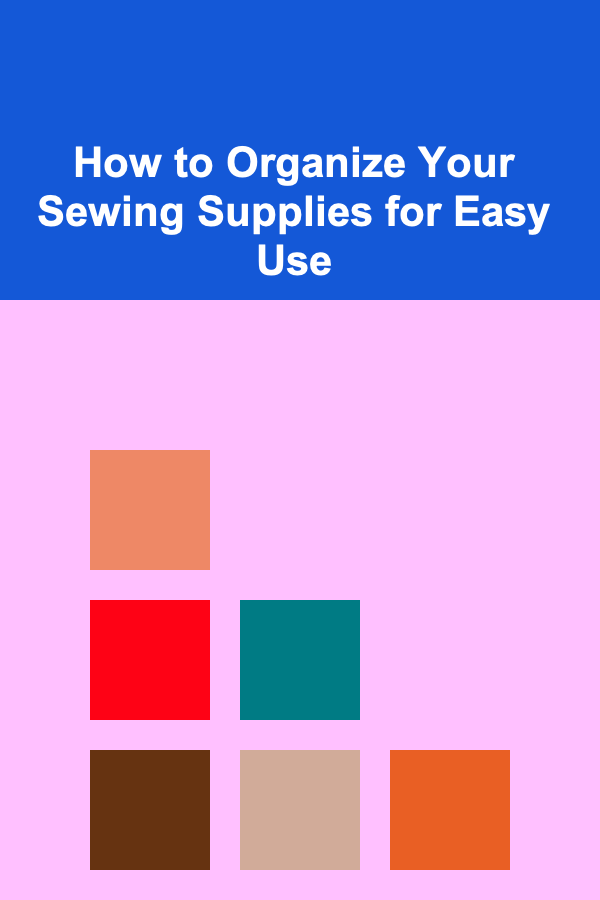
How to Organize Your Sewing Supplies for Easy Use
ebook include PDF & Audio bundle (Micro Guide)
$12.99$8.99
Limited Time Offer! Order within the next:

Sewing is a comforting and rewarding hobby that allows individuals to express creativity and produce tangible results. However, one of the most common challenges faced by sewists---whether beginners or seasoned professionals---is managing the multitude of supplies needed for this craft. From fabrics and threads to tools and patterns, keeping everything organized can minimize frustration and maximize productivity. This comprehensive guide will explore effective strategies for organizing your sewing supplies, ensuring they are easily accessible and ready for use whenever inspiration strikes.
Introduction
Sewing has experienced a resurgence in popularity due to its therapeutic nature and the ability it provides to create unique garments and home textiles. However, without an organized system to manage your supplies, the joy of sewing can quickly turn into frustration. A cluttered workspace often leads to wasted time searching for materials, decreased motivation, and even mistakes in your projects.
By implementing a thoughtful organization strategy, you can ensure that your sewing supplies are easily accessible and well-maintained. This article aims to provide practical steps to help you declutter, categorize, and store your sewing essentials effectively.
Understanding the Importance of Organization
1. Enhanced Efficiency
An organized space facilitates quicker access to necessary items, allowing you to focus on your creative process rather than searching for materials. When everything has a designated place, it becomes second nature to find what you need.
2. Stress Reduction
A tidy workspace contributes to a calmer mindset. Clutter can be overwhelming, causing anxiety and reducing your overall enjoyment of sewing. By creating order, you foster a more serene environment conducive to creativity.
3. Improved Project Quality
When your supplies are organized, you reduce the chances of making mistakes, such as using the wrong thread color or cutting fabric incorrectly. Having everything in its proper place ensures that your projects are completed with greater accuracy and care.
4. Increased Motivation
Seeing an organized space can inspire you to take on new projects and experiment with different techniques. A clean and appealing environment encourages a proactive approach to sewing.
Assessing Your Sewing Supplies
Before organizing, assess what you have:
1. Gather Everything
Collect all your sewing supplies in one location. This includes fabrics, threads, tools, patterns, and any other items related to sewing.
2. Categorize Items
Sort your supplies into broad categories such as fabric, thread, tools, and patterns. This initial sorting will serve as a foundation for further organization.
3. Evaluate Condition
Inspect each item. Discard or donate anything damaged or that you no longer use. This step helps to streamline your collection to only what is essential.
Choosing Appropriate Storage Solutions
The right storage solutions play a significant role in maintaining organization. Here are various options to consider:
4.1 Bins and Boxes
Clear Plastic Bins: Clear bins allow you to see contents easily. They come in various sizes and can be stacked for efficient use of vertical space.
Fabric Bins: These fabric-covered bins add a decorative touch while providing functional storage. Look for ones with lids to keep dust out.
4.2 Shelving Units
Open Shelving: Open shelves are excellent for displaying neatly folded fabrics, which adds visual interest to your space while keeping supplies within reach.
Adjustable Shelves: Consider adjustable shelving to accommodate different heights of items over time. This flexibility can be beneficial as your collection grows.
4.3 Pegboards
Wall-Mounted Pegboards: Pegboards are versatile and perfect for hanging tools like scissors, rulers, and rotary cutters. Add hooks, baskets, and shelves to customize your setup.
4.4 Rolling Carts
Mobile Storage Carts: Rolling carts can be moved around easily, giving you flexibility in your workspace. Use them for frequently used items or ongoing projects.
Organizing by Category
Once you've gathered your supplies and selected suitable storage solutions, it's time to organize by category.
5.1 Fabric
Sorting Fabrics
- Types of Fabric: Separate cottons, knits, silks, and other materials.
- By Color: Within types, consider organizing by color for easy matching.
Storage Options
- Folding: Fold fabrics neatly to avoid creases. Store them vertically if possible, as this prevents damage.
- Clear Bins: Use clear bins or open shelving to keep fabrics visible and accessible.
5.2 Thread
Organizing Threads
- Thread Types: Sort by type (e.g., polyester, cotton) and weight (e.g., regular, specialty).
- Color Coding: Arrange spools by color, making it easier to find the perfect match for your project.
Storage Ideas
- Thread Racks: Wall-mounted or freestanding racks keep spools organized and visible.
- Boxes or Bins: Use small bins to keep loose threads sorted by color or type.
5.3 Tools
Tool Categories
- Cutting Tools: Scissors, rotary cutters, and cutting mats should be grouped together.
- Measuring Tools: Keep tape measures, rulers, and quilting squares in one area.
- Sewing Notions: Organize pins, needles, and seam rippers in a dedicated container.
Storage Solutions
- Toolboxes: Small toolboxes can keep tools secure and organized, especially when traveling to classes or workshops.
- Drawer Inserts: Use drawer organizers to keep small items separated and easily accessible.
5.4 Patterns
Managing Patterns
- Type of Pattern: Group patterns by type (garments, quilts, accessories) or by intended recipient (adult, child).
- Digital vs. Physical: If you have digital patterns, consider keeping a tablet or laptop in your nook for easy reference.
Storage Options
- Folders or Binders: Use binders with plastic sleeves to protect physical patterns from damage.
- File Boxes: For digital users, traditional file boxes can hold printed patterns and notes.
Labeling Your Supplies
Proper labeling is crucial for maintaining organization. Here are some tips:
1. Use Clear Labels
Labels should be easy to read and understand. Use a consistent font and size across all labels.
2. Color-Coding
Consider color-coding your labels based on categories (e.g., blue for fabrics, red for tools). This visual cue can speed up identification.
3. Digital Labels
For those who prefer a modern approach, consider using a label maker to create professional-looking labels, or design custom labels on your computer.
4. Label Storage Bins
Make sure every storage bin is labeled clearly, indicating what's inside. This minimizes confusion and speeds up retrieval.
Creating a Functional Workspace
With your supplies organized, focus on optimizing your workspace.
1. Desk Setup
- Ergonomics: Position your desk at a comfortable height. Ensure your sewing machine and tools are within arm's reach.
- Waste Management: Keep a wastebasket nearby for fabric scraps and thread clippings.
2. Lighting
- Natural Light: Position your workspace near windows if possible. Daylight improves mood and visibility.
- Task Lighting: Invest in an adjustable desk lamp. Make sure it provides adequate light directly onto your work surface.
3. Seating
Choose a comfortable chair that provides support for long hours of sewing. An ergonomic chair can significantly impact comfort and productivity.
Maintenance Tips for Your Organized Space
Maintaining an organized sewing space requires regular attention. Here are some strategies:
1. Daily Tidying
Make it a habit to tidy your workspace at the end of each session. Put away tools and materials to prevent clutter from accumulating.
2. Regular Audits
Set a schedule for conducting regular audits of your supplies. Every few months, review what you have and reassess your organizational methods.
3. Seasonal Decluttering
Use changes in seasons or holidays as an opportunity to declutter and reorganize. This helps refresh your space and keeps it functional.
4. Stay Flexible
As your sewing projects evolve, so may your organizational needs. Be open to adjusting your setup to maintain efficiency and ease of use.
Conclusion
Organizing your sewing supplies is not just about aesthetics; it's about creating a functional, inspiring workspace that enhances your creativity and productivity. By assessing your supplies, choosing appropriate storage solutions, and establishing an organized system, you can transform your sewing nook into a haven for your craft.
Investing time in setting up an organized workspace pays off in increased efficiency, reduced stress, and a more enjoyable sewing experience. Embrace the joy of sewing by creating a cozy, well-organized space where your creativity can flourish! Whether you are sewing clothes, quilts, or home decor, a tidy environment will help you achieve your goals with ease and satisfaction. Happy sewing!
Reading More From Our Other Websites
- [Organization Tip 101] How to Keep Your Freezer Organized for Meal Prep
- [Organization Tip 101] How to Create a Relaxing Outdoor Reading Nook
- [Organization Tip 101] How to Incorporate Sustainability Practices in Rental Management
- [Home Renovating 101] How to Update Your Home's Flooring Without Replacing Everything
- [Personal Finance Management 101] How to Navigate Financial Challenges During Economic Uncertainty
- [Home Rental Property 101] How to Find Houses for Rent with an In-Law Suite: A Comprehensive Guide for Multi-Generational Families
- [Weaving Tip 101] Timeless Threads: How Weaving Benefits Cognitive and Motor Skills Across All Ages
- [Organization Tip 101] How to Use Clear Bins for Effective Closet Organization
- [Personal Investment 101] Monetizing Your Deep Learning Models for Passive Income
- [Home Security 101] How to Secure Your Home Against Package Theft

Eco-Savvy Factory Leadership: Implementing Sustainable Practices
Read More
How to Create a Customer Feedback Management Checklist for Social Media Feedback
Read More
How to Create a Toy Maintenance Schedule
Read More
How to Pet-Proof Your Home for Safety
Read More
How to Set Up a Dessert Bar for Your Home Party
Read More
How to Floss Properly: A Step-by-Step Guide
Read MoreOther Products

Eco-Savvy Factory Leadership: Implementing Sustainable Practices
Read More
How to Create a Customer Feedback Management Checklist for Social Media Feedback
Read More
How to Create a Toy Maintenance Schedule
Read More
How to Pet-Proof Your Home for Safety
Read More
How to Set Up a Dessert Bar for Your Home Party
Read More